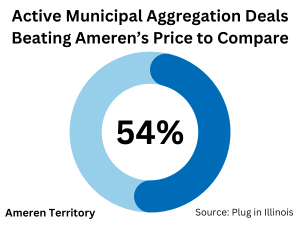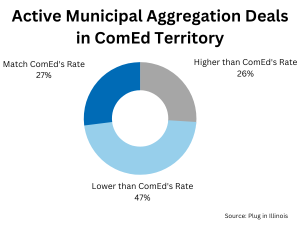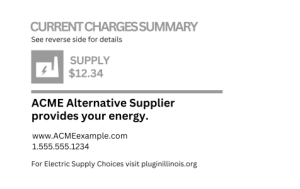Out of 485 active community power (“municipal aggregation”) offers, about 300 (62 percent) beat or at least matched the utilities’ summer supply rates, according to a CUB review of plans. But more than half (183) of those offers expire over the next year–many of them this December.
This comparison covers the utilities’ summer supply rates (ComEd’s price of about 6.8 cents per kilowatt-hour [kWh] and Ameren’s rate of 7.877 cents per kWh), which began in June. Those prices are changing slightly as of Oct. 1 (ComEd: 6.872 cents per kWh for all usage; Ameren Illinois: 8.107 cents per kWh for up to 800 kWh of usage; beyond that, 7.094 cents per kWh). Customers on municipal aggregation offers should review their price and how it compares to their utility’s supply rate, learn how long their contract lasts, and educate themselves on their options.
ComEd and Ameren electricity customers have the option to choose another company to supply them with power. (ComEd and Ameren will still deliver the electricity to you and bill you, but you can have another company supply the actual electricity.) This choice comes in two forms:
- You can choose a company that markets you over the phone, via mail or door-to-door.
- Your community or county leaders can negotiate with a supplier in hopes of securing a reasonable electricity rate for residents. This is called a community power deal, or municipal aggregation.
A local government has to obtain approval, through a referendum, to launch a municipal aggregation program. Once the program is OK’d and local leaders negotiate a deal with a supplier, most residents are entered into the offer automatically, unless they opt-out. The contracts are typically one to three years.
Overall, Illinois consumers have lost about $1.6 billion to alternative suppliers since 2015. By far, the biggest problems have come from companies that market individual customers through telemarketing, mail and door-to-door sales. Municipal aggregation has been a more consumer-friendly form of electric competition–but it does not guarantee savings.
Below is what CUB found during a September review of municipal aggregation offers listed on the State of Illinois’ electric competition website, Plug In Illinois. Many communities offered their residents green, or renewable energy-based, plans, which typically have a higher price. At least 27 communities offered customers both green and non-green options–in those instances CUB’s analysis used the non-green price. (Reasonably priced municipal aggregation green plans can be a legitimate option for interested consumers. At the bottom of this article we also list other choices that can help you be green and cut your utility bills at the same time.)
Ameren Territory 
- Of 293 active municipal aggregation offers, 157 (54 percent) were beating Ameren Illinois’ utility price. Of those 157 offers, 136 expire within the next 12 months. In fact, 131 of the cheapest offers in Central and Southern Illinois are set to end this December.
- The community deals were charging an average rate of 8.05 cents per kilowatt-hour (kWh), compared with Ameren’s summer supply rate of 7.877 cents per kilowatt-hour (kWh), from June through September.
- The prices charged by these community deals ranged from a low of 4.95 cents per kWh to a painful 12.64 cents per kWh.
- The 119 highest priced plans–about 9.9 cents per kWh or more–were dominated by two companies, Constellation and Energy Harbor. Those plans–including 69 that were more than 11 cents per kWh–last at least until next summer, and a few into 2025 and 2026.
ComEd Territory
- Out of 192 municipal aggregation deals, 143 (75 percent) meet or beat ComEd’s summer supply rate of about 6.8 cents per kWh (91 beat the utility price, and another 52 claimed to match ComEd’s price).
 Out of those 143 offers, 47 are ending within the next 12 months, including 24 by the end of 2023.
Out of those 143 offers, 47 are ending within the next 12 months, including 24 by the end of 2023. - Aside from the offers that claimed to match ComEd’s price, the community deals were charging an average rate of 6.69 cents per kilowatt-hour (kWh), compared with ComEd’s summer rate (June – September) of about 6.8 cents per kWh. The aggregation offers ranged from 5.158 cents per kWh to an outrageous 11.89 cents per kWh.
- Of the 15 highest prices in this range (8.17 cents per kWh and up), 12 were offered by two companies that also charged high rates in Ameren territory: Energy Harbor or Constellation.
Read our Q&A for tips:

How do I know if my community has a municipal aggregation deal?
- Check the municipal aggregation list at the state of Illinois’ electric competition website, Plug In Illinois.
- If your community has a power deal, then look at the supply section of your bill (hypothetical example, at left) to see if the company listed there matches the company on the municipal aggregation list.
So what do I do if I’m on a municipal aggregation plan?
Confirm what price you’re paying, and if it’s lower than the utility supply rate, stay on the offer for as long as you can. These are the utility supply rates as of Oct. 1: ComEd, 6.872 cents per kilowatt-hour (kWh); Ameren Illinois, 8.107 cents per kWh for up to 800 kWh of usage; beyond that, the rate is 7.094 cents per kWh.
Customers on municipal aggregation offers should review their price and how it compares to their utility’s supply rate, learn how long their contract lasts, and educate themselves on their options.
What if my municipal aggregation offer is losing me money?
If you want to leave your municipal aggregation plan, call the company listed on the Supply section of your bill to switch back to the utility. You should not have to pay an exit fee, but the process can take up to two months. Note: You may be willing to pay a little extra for your municipal aggregation offer if it’s a renewable energy-based plan (a.k.a. a “green plan). That is a legitimate choice, and a community power deal may be a good opportunity to take advantage of a reasonably priced green plan. You also have other options: If you are concerned about the environment, we list other ways to help the planet, and save money, below (energy efficiency, demand response programs, solar panels, community solar).
What do I do if my municipal aggregation contract is ending?
Find out if your community is negotiating a new aggregation deal, or if it’s sending everyone back to your utility. If your community is negotiating a new offer, find out what the new rate is and how it compares to your utility rate. Also, find out how long the offer lasts.
If it’s best to go back to your utility, consider other options to lower your costs. (See below.)
What are other ways to make my electric bills more affordable?
- See if you qualify for energy assistance. The application process for the Low Income Home Energy Assistance Program (LIHEAP) reopens on Oct. 2. To apply or learn more, visit www.helpillinoisfamilies.com or call the Help Illinois Families Assistance Line at 1-833-711-0374.
- Practice energy efficiency. The utilities offer no- and low-cost programs to help cut costs. (Pro tip: Consider a Home Energy Assessment, offered by ComEd and Ameren (Ameren’s program is for income-qualified customers).
- Consider joining ComEd Peak Time Savings/Ameren Peak Time Rewards. These programs (one for ComEd customers, and one for Ameren customers) give you a bill credit if you’re able to reduce your energy usage for a limited number of hours on certain days (typically hot summer afternoons) when electricity demand is highest. Demand response programs like these give you incentives to reduce energy usage when demand is at its peak and fossil-fuel power plants work their hardest. Since a significant part of our power bills goes to making sure power plants can meet high demand, lowering peak demand can cut our costs.
- Consider joining ComEd Hourly Pricing/Ameren Power Smart Pricing. These demand-response programs–Hourly Pricing and Power Smart Pricing–charge a wholesale market price that can change hourly, compared with the traditional rate that only changes about twice a year. They encourage customers to put off heavy energy usage (laundry, for example) until prices are lowest: late night and early morning. These programs reduce peak demand and cut the need for fossil-fuel power plant operation. While savings are not guaranteed, typical participants have saved an average of 10-15 percent on their electricity supply costs.
- Explore solar power: Consider installing solar panels using new state and federal incentives. Or, if that’s not an option, check the Community Solar deals in your service area. Community solar allows you to enjoy the benefits of solar power (lower bills) without having to install panels on your property. Currently, all community solar deals claim to save participants money compared with the utility’s supply price, but make sure to read the fine print and check out our shopping tips. Plus, remember that the waiting list for offers can be months, even up to a year.
For more information, check out CUB’s Electricity page and Plug In Illinois’ Frequently Asked Questions on Municipal Aggregation.

